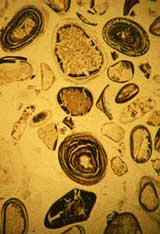DNA downloads alone

Two million years ago life looked like this. Four billion years ago it was a different story. <br>© SPL <br>
The information in DNA can be copied into new molecules without proteins’ help.
Chemists have reproduced the basic process of information transfer central to all life without the catalysts that facilitate it in living cells1.
They show that DNA alone can pass its message on to subsequent generations. Many researchers believe that DNA-like molecules acted thus to get life started about four billion years ago – before catalytic proteins existed to help DNA to replicate.
The experiment, carried out by David Lynn and co-workers at Emory University in Atlanta, Georgia, might create a new basis for the precise synthesis of useful polymer materials. It may even hasten the advent of synthetic biology: the creation of life from scratch.
History repeats itself
Synthetic self-replicating molecules have been made in the lab at least three times before. But in all these cases the replicating molecules were given a substantial helping hand.
Before, each molecule acted as a template on which its copy was constructed from two ready-made halves. In other words most of the information in the copy was present already in the fragments from which it was made. It was rather like reproducing the information in this sentence simply by pasting it together from two already-written halves.
In contrast, Lynn and colleagues paste each letter in place, one by one. They make, not a copy, but a complementary molecule, containing the same information but in a different code. It is rather like making a copy of one of these sentences but translated into French.
In the cell, DNA itself contains two such complementary molecules, each one a chain of molecular units, stuck together in the double helix. When DNA replicates before a cell divides, these complementary strands part and each acts as a template to guide the synthesis of a fresh strand.
Each DNA strand contains all the information needed to make a new strand. There are four different kinds of molecular unit, and the sequence of these along the strand determines the sequence of units assembled in the new strand. Enzymes drive this assembly process.
Stranded
Lynn’s group has found a way to do without the enzymes, so that a single strand of DNA can act as a template for the assembly of its complementary strand. Scientists have achieved this before, but imperfectly: only one of the four types of DNA unit acted as a template, and the complementary strand wasn’t always the same length as the template.
The Emory group uses a new trick to join the components together on a DNA template. The chemical links between successive units in the new strand aren’t like those in DNA itself. Instead they are amide linkages, like those that unite proteins’ molecular units, which are also chain-like molecules laden with information. This makes the assembly of the new strand more accurate.
Amide-linked DNA chains can help units of true DNA to join together. So the researchers hope to achieve the reverse process of templating DNA using amide-linked DNA. This might then enable the two kinds of molecule to support their mutual replication, allowing the possibility of molecular evolution and the appearance of life-like complexity.
References
- Li, X., Zhan, Z.-Y. J., Knipe, R. & Lynn, D. G. DNA-catalyzed polymerization. Journal of the American Chemical Society, 124, 746 – 747, (2002).
Media Contact
More Information:
http://www.nature.com/nsu/020204/020204-2.htmlAll latest news from the category: Life Sciences and Chemistry
Articles and reports from the Life Sciences and chemistry area deal with applied and basic research into modern biology, chemistry and human medicine.
Valuable information can be found on a range of life sciences fields including bacteriology, biochemistry, bionics, bioinformatics, biophysics, biotechnology, genetics, geobotany, human biology, marine biology, microbiology, molecular biology, cellular biology, zoology, bioinorganic chemistry, microchemistry and environmental chemistry.
Newest articles

First-of-its-kind study uses remote sensing to monitor plastic debris in rivers and lakes
Remote sensing creates a cost-effective solution to monitoring plastic pollution. A first-of-its-kind study from researchers at the University of Minnesota Twin Cities shows how remote sensing can help monitor and…

Laser-based artificial neuron mimics nerve cell functions at lightning speed
With a processing speed a billion times faster than nature, chip-based laser neuron could help advance AI tasks such as pattern recognition and sequence prediction. Researchers have developed a laser-based…

Optimising the processing of plastic waste
Just one look in the yellow bin reveals a colourful jumble of different types of plastic. However, the purer and more uniform plastic waste is, the easier it is to…



